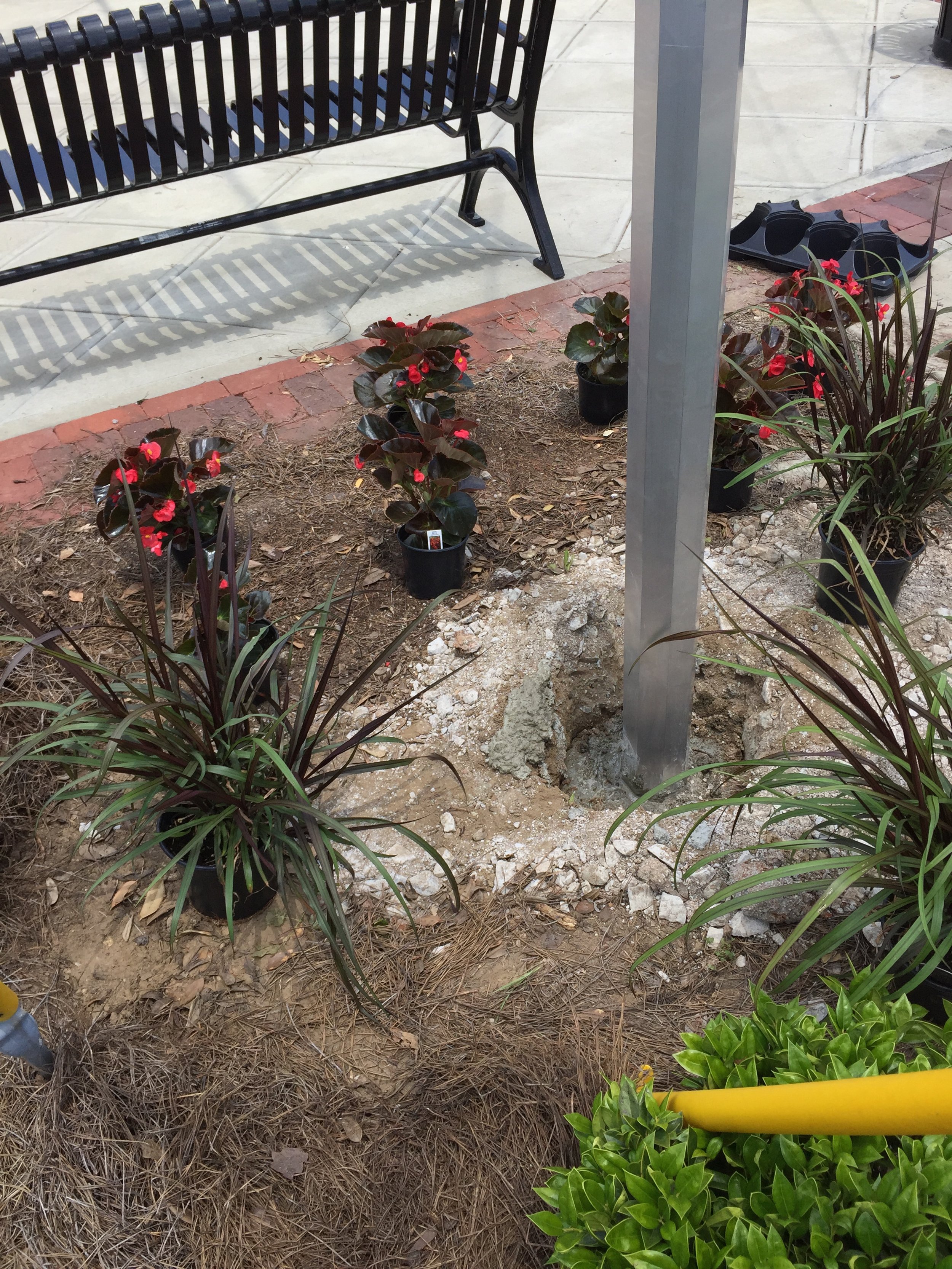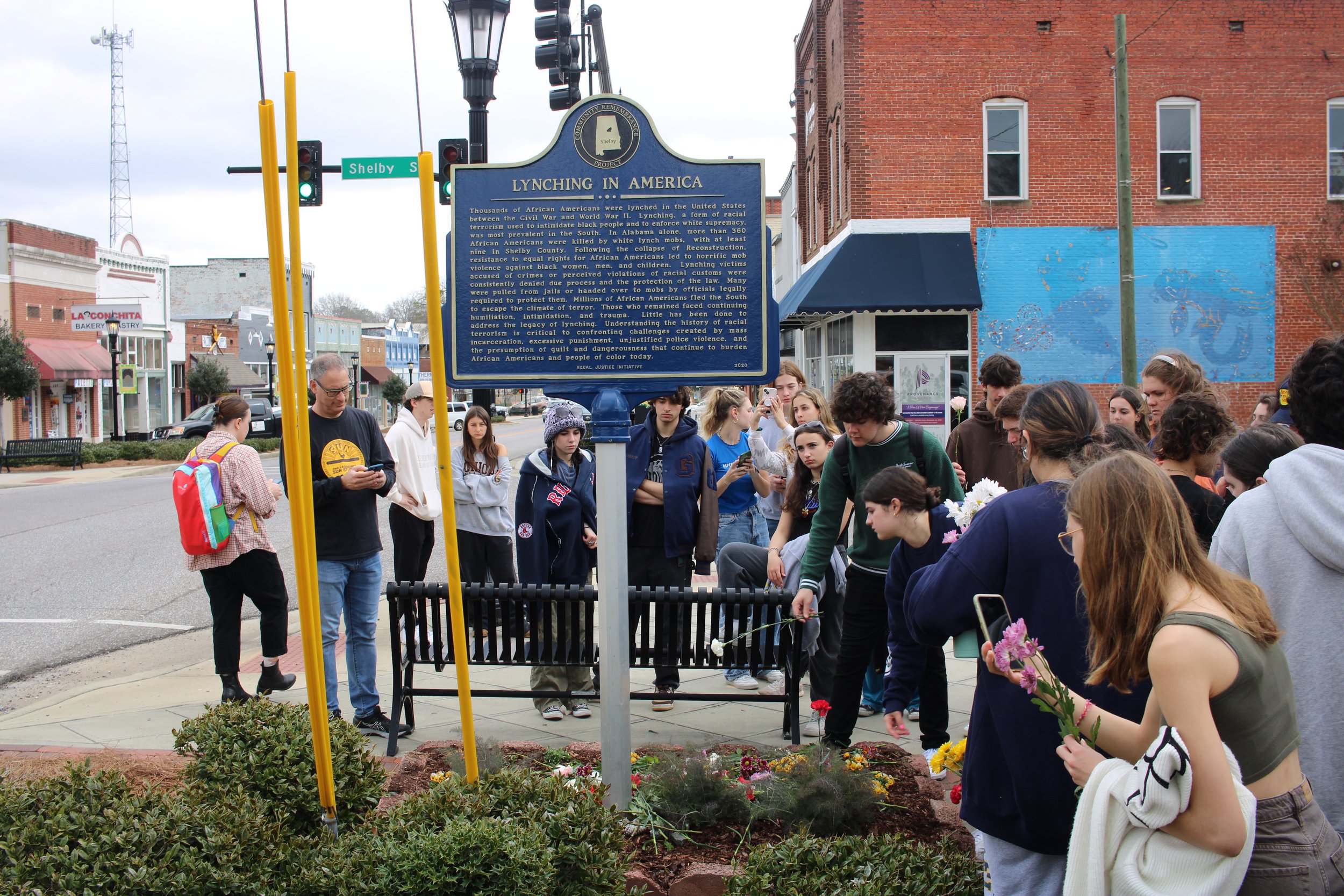The soul of the garden
Ed. note: August 31 marked the anniversary of a double lynching that occurred on Montevallo's Main Street in 1889. A marker, installed June 2020 as part of EJI's historical marker project, commemorates one of the more than 300 lynchings in Alabama that the Equal Justice Initiative has been able to document. Since then, with lots of help from Barton's Nursery in Alabaster, the author has maintained a memorial garden at the marker's base. These are her reflections.
I tend a small plot of land at the corner of Main and Shelby streets in Montevallo, Alabama. It is city property. In the absence of an official name I call it the Memorial Garden. Ornamental grasses and flowering plants honor with their beauty two persons hanged in 1889 from the limb of a tree that once stood nearby. Their names are unknown.
The garden, located at the base of one of EJI's lynching markers, began as a problem to be solved.
The site selected by the city for the marker was a small piece of land, about 5 feet by 7, very near the site of the 1889 double lynching. The ground itself was unpromising -- the most gawd-awful compacted yellow clay imaginable. Its surface was overlaid with mini-clumps of concrete radiating from the base of a marker post that had been sunk some two feet deep.
The base of the Lynching Marker.
The solution was an improvised raised bed garden bordered by pavers and filled with what was sold and delivered as topsoil. Topsoil? The yellowish dirt was nearly as poor as the clay beneath. I have had to reconcile myself to an unending process of soil amendment.
At first I was so fixated on getting something to grow in this graceless soil that I gave little thought to the meaning of the garden.
But I knew from the start that I wanted to avoid the stiff, formal, soulless display of beat-the-heat flowers favored by landscapers at the entrance to new subdivisions. I leaned toward grasses and herbs, plants that would bend in the wind and give the feeling of a natural setting.
Twice I used bronze fennel as the background. It is tall, feathery, aromatic, and, to my mind, just right for honoring bronze-skinned people.
Bronze fennel is host plant to swallowtail butterflies.
In some African traditions butterflies symbolize the spirits of the departed. In many cultures butterflies are associated with change, rebirth, freedom -- and dreams of freedom. I like to imagine that the souls of people who died in terror might here find a kind of new life; a dignity and respect appallingly absent in their final chaotic hours.
The lives of the two persons lynched meant so little to the non-Black community that no one thought to record their names. They are usually referred to as men. But people of color who fell prey to a mob's rage were often just kids. The persons commemorated may have been young men still in their teens. We may never know.
The soul of the garden was revealed to me more fully in February 2023. Nearly 100 students, faculty, and staff from a Jewish high school in Los Angeles were bussed to Montevallo for a remembrance ceremony at the marker. They were led by Rabbi Adrianne Pasternak, Director of Immersive Experiences for Tzedek America.
Kathy King at the memorial garden in 2023. High school students from Los Angeles visited Montevallo during their tour of southern civil rights sites, honoring the lynching marker with prayers, stones, and flowers.
Students place flowers in the memorial garden.
Several members of the local African American community spoke from the heart about what the marker means to them and the community. They were followed by a reading of the Mourner's Kaddish, the Jewish prayer for the dead. Students then placed visitation stones beneath the marker. In Jewish bereavement traditions the placing of stones is an act of remembrance and respect. I learned that the Kaddish is sometimes said for those who have no one to speak on their behalf, sometimes victims of the Holocaust who might otherwise be unremembered.
The Memorial Garden is the closest thing we have to a gravesite for persons with no names, no history, and no known place of burial.
“We often wish to be able to address our dead at particular sites on the Earth’s surface. . . . The grief of those who have been unable to locate the bodies of their loved ones can be especially corrosive — acid and unhealing.”
Earlier this year, I felt called to replace the brightly colored blooms of other summers with an all green-and-white color scheme. Visitors will now see the pure white flowers of cascading vinca and butterfly-like white flowers of gaura. One variety of gaura is actually called whirling butterflies.
Paul Mahaffey, a member of the Montevallo Community Remembrance Project, stands at the Lynching Marker and Memorial Garden.
White is a healing color, some say, associated with truth, cleansing, and protection. With removal of pain and suffering. A flier for this year's annual MAAFA event in Montgomery, a day to "Remember the Ancestors," encourages participants to wear "all white."
The Memorial Garden will mean differently for different people. For some, it means feelings of pain, grief, shame, and anger evoked by the very thought of lynchings in Alabama. For some, commitment to racial justice. For some, belated respect for two persons for whom this small piece of land serves as a final resting place.
My hope: that this garden is a place of remembrance; an occasion for truth, healing, and reconciliation. Come visit the Memorial Garden at the corner of Main and Shelby streets in Montevallo. Tell us how it speaks to you.
-- Kathy King, August 2024
Kathy King is co-founder and president of the MLP as well as co-leader of the EJI historical marker project known as the Montevallo Community Remembrance Project. The marker at the corner of Main and Shelby streets, a partnership between the city and EJI, calls attention to one of the lynchings in Alabama documented by EJI.








